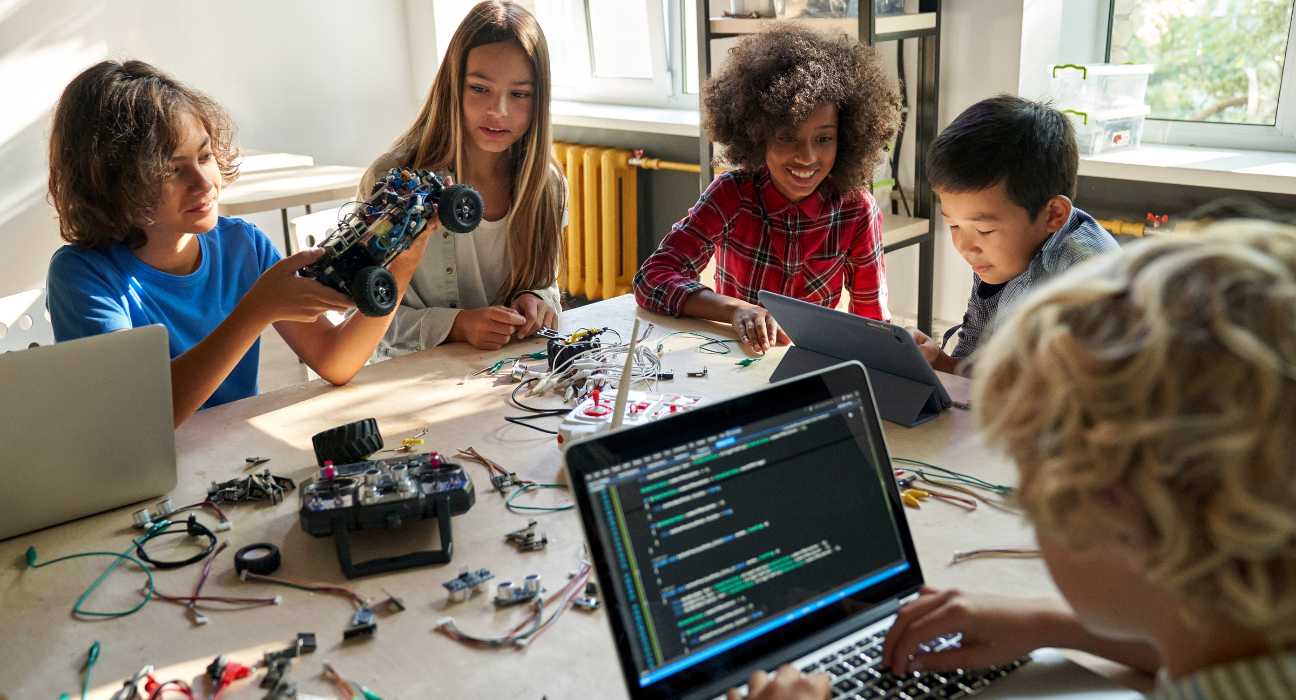Imagine a classroom where every student receives personal attention; lessons will change at real-time rates to suit the learning temperament of each student, and large amounts of administrative burdens are reduced for educators. This is not science fiction; this is AI today, in education.
Artificial intelligence has currently been carving a niche in various industries, and education is no exception. From personalization in experiences to automation in administrative tasks, AI dramatically changes the educational landscape toward effective, inclusive, and engaging learning. The ways AI is reshaping education become apparent as we delve deeper, and its potential proves to be extensive and multi-dimensional in scope.
In this article, we will go through ten revolutionary ways in which AI is advancing learning experiences and outcomes and prove that this technology is going to be the future of education. The integration of AI into educational frameworks helps resolve current implicit and transcendent challenges for institutions while being on their way to build innovative learning environments for the future.
10 Applications of AI in Education
Personalized Learning
This could be one of the biggest impacts of AI in education, making it possible for each student to be taught differently. Algorithms in this case can analyze the learning patterns of students and accordingly tailor the education material. This only goes way beyond simple adaptive learning into rich educational experiences that can deal with very different learning styles and preferences.
Examples: Smart Sparrow and DreamBox both adjust the lesson based on the student’s offers to ensure that the students receive the right level of challenge and support. Smart Sparrow uses adaptive learning technologies programmatically generated onto individual courses of instruction of students. The latter, DreamBox, streamlines its offering to math education, where problems are dynamically changed in real time based on a student’s performance analysis.
Benefits: Increased engagement, better retention, and more meaningful learning experiences are achieved as students pace themselves through. In addition, personalized learning will also build in the student a sense of ownership and autonomy by putting them in charge of their learning journey.
Intelligent Tutoring Systems
AI-powered ITS allows for the monitoring of efforts by students in real-time, offers individual tutoring, and provides timely feedback, very much like a human tutor as it understands the needs of the student, topic mastered or not mastered, and provides the relevant instruction.
Examples: It uses artificial intelligence for delivered, personalized tutoring sessions in an attempt to get students to really understand the concepts and improve their skills. For example, MATHia by Carnegie Learning adapts to each student’s style and pace with individualized guidance. Squirrel AI uses artificial intelligence to review student performance and tailor the instruction.
Benefits: The systems are there to help the learner on demand so that they can get instructions tailored for them anytime in the day for better understanding and higher academic achievement. Intelligent tutoring systems provide scalable solutions to the tutor shortage problem and guarantee quality support to each learner regardless of geographical location.
Automating Administrative Tasks
It reduces most of the administrative workload of teachers by automating tasks like grading, scheduling, and workflow management. This automation of administrative tasks frees educators to have more time to teach and spend with students.
Examples: AI-driven tools can grade multiple-choice quizzes and even give feedback on written work, freeing up loads of time for teachers. Tools like Gradescope, using AI to assist in grading and feedback—and also administrative ones like Knewton, help with scheduling and resource allocation, letting AI ease their administrative load.
Benefits: The more focus on teaching and contact with students prevents burnout and makes the classroom more efficient. AI takes care of routine tasks so that educators can use their energy on effective tasks, for instance, development of a curriculum or supporting students.
Enhancing Accessibility
It is AI that helps in making education accessible, segregatedly to learners with disabilities. The artificial intelligence system not only helps students through assistive technologies but also in the adaptation of content per individual needs, thereby making it feasible for all to have an opportunity and excel.
Examples: These might include speech-to-text and text-to-speech technologies that enable students to access educational material in different forms and AI-driven language translation tools. In this case, examples would be Otter.ai, which provides real-time transcription, while Microsoft’s Immersive Reader would be required for its text-to-speech and translation functionality to make the content accessible to each and every one.
Benefits: These technologies are inclusive, make full participation of students with disabilities in school activities possible, break language barriers for non-native speakers, and promote the diversity of a learning environment by making all students feel important and appreciated. More access to education increases diversity within the learning environment, hence making all students feel important and appreciated.
Predictive Analytics
AI provides predictive analytics to head off student performance and create leads on problems before they become significant. Here, AI analyses a wide bank of data points to give insights into student behaviour, engagement, and progress at school.
Examples: AI-powered early warning systems detect students deemed at risk by their academic performance and level of engagement. Tools like BrightBytes and Starfish employ predictive analytics to track student data, which delivers actionable intelligence to educators for quick interventions.
Benefits: Educators are able to offer timely interventions while students can get tailored support and resources. This will help students to succeed thus increasing the rate of success. Predictive analytics also enable data-driven decision-making allowing resource allocation and designing intervention targeted at institutions.
Virtual Reality and Augmented Reality
AI enhances learning experiences by incorporating virtual and augmented reality, thereby providing an immersive experience in education. These can take one to other worlds and enforce experiential learning, which is way beyond the classrooms.
Examples: Tools leveraged to achieve this include giants like Google, with its Expeditions and zSpace, an AI-based, engaging virtual and augmented reality experience enabler for students to look around, examine historical sites, carry out experiments online, and more. While Google Expeditions offers a myriad of virtual field trips, zSpace deals with the interactive learning platforms connected to STEM education.
Benefits: Such technologies make learning interactive and more engaging, allowing the students to gain a better understanding of the complex concepts being passed across through practical experiences. VR and AR also tend to serve diverse ways of learning, therefore making education more inclusive and enjoyable to the student population that is diverse.
Adaptive Testing
AI-driven adaptive assessment platforms modulate assessment tools in real time by using students’ performance to alter the difficulty of the assessments. This dynamic assessment method tailors the difficulty level to suit individual ability and, therefore, may provide a more realistic picture of the knowledge at hand.
Examples: Modern computer adaptive testing systems are based on the analysis of students’ responses to questions and automatic regulated prompting for more or less difficult questions. Other companies, such as Edmentum and Renaissance Learning, offer adaptive testing that scales performance-based questions to ensure the fairness and equity of assessment for students.
Benefits: The benefits of this approach are more accurate measurements of student abilities and the creation of a personalized learning path according to strengths and weaknesses. Adaptive testing reduces test anxiety since students only receive questions within their current skill levels.
Enhancing STEM Education
AI has significant effects on STEM education and enlightens innovation and critical thinking. AI integrated into STEM curricular activities aids students in getting hands-on experience, experiential learning to set them back into the job market.
Examples: AI-powered, inquiry-based labs and coding learning platforms that place students in hands-on experiences to test and self-explore concepts in STEM at their depth. Tools like Labster provide virtual science labs, while platforms like Code.org engage students in programming and computational thinking activities through AI-enhanced coding lessons.
Benefits: There are tools that set students thinking innovatively and solving problems, thus preparing them for STEM careers in the future. By giving examples of how STEM concepts are used in real life, AI makes students more interested and interested, motivating the development of a life-long interest in science and technology.
Language Learning
Explanation: Artificial intelligence, therefore, facilitates language learning by providing users with engaging interactive tools that respond in real-time. The tools are customized according to the learning styles of individuals so that the process of learning a new language is both effective and enjoyable.
Examples: AI forms an intrinsic part of platforms like Duolingo or Babbel, which generate individual language lessons, while AI chatbots allow one to practice and converse. Duolingo’s AI-driven approach scales the level of difficulty of lessons according to user performance, and Babbel offers personalized feedback that helps in language proficiency.
Benefits: AI-powered language learning tools get easier to make students learn new languages and thus equip them with skills to communicate across borders and develop cultural understanding. They also offer several flexible learning opportunities; students can practice at their own pace in developing their language skills.
Collaborative Learning
Artificial intelligence tools make students learn cooperatively by facilitating group projects and discussions. In this regard, teachers can enable collaborative learning systems with teamwork and knowledge-sharing aspects through the use of AI.
Examples: AI-driven discussion forums and group project tools make it easy for students to work together even when they aren’t in the same room. Other platforms—and Piazza is one such platform—comes complete with AI that facilitates online discussions. Microsoft Teams, for instance, also comes equipped with AI-enhanced collaboration features for group projects.
Benefits: Such technologies afford students the ability to work in a team, share learning experiences, and have multiple perspectives that are significant in the development of essential collaborative skills in the future. Collaborative learning enhances critical thinking and problem-solving by showing students how to manage different opinions and finally work together in achieving common objectives.
Conclusion
Summary: Personalization of learning, provision of intelligent tutoring, automation of administrative tasks, support of access, employment of predictive analytics, integration of VR and AR, supports adaptive testing, reinforces STEM education, supports language learning, and fosters social and collaborative learning. All these involve meeting definite challenges in the educational sector, thereby bringing learning to efficacy, inclusivity, and engagement.
Future Outlook: With further developments in the future, AI in education has unlimited potential. Further improvements would have personalized learning become more enhanced, more advanced tutoring systems, and the development of elements that are not yet created for delivering instructional content. This is just the beginning since the use of AI in education is bound to grow, which will see more and more innovations and efficiency in the learning and teaching process.
Call to Action: Both educators and educational institutions should accept the AI technologies for reaping these benefits and to prepare the students for a future where AI should be an integral part of everyday life. Educational institutions would do well to usher in new and better ways to keep themselves at the cutting edge of innovation in AI so that students enjoy the very best learning and experience transformation processes.

